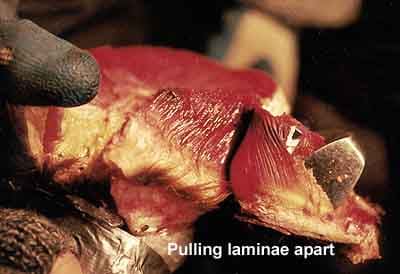
Treating Founder (Chronic Laminitis) without Horseshoes, Section 1
(Version with full-sized photos)

Dissection, showing the laminae being pulled apart.
The laminae are what suspend the coffin bone in the hoof capsule.
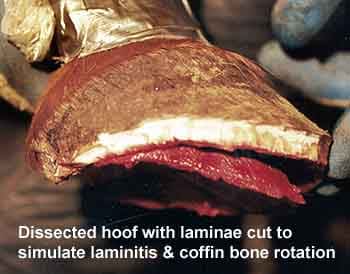
Dissection, showing how the coffin bone rotates
when the weakened laminae can no longer support it
after laminitis has weakened the laminae.
(Laminae were cut in this dissection to simulate
laminitis and coffin bone rotation.)
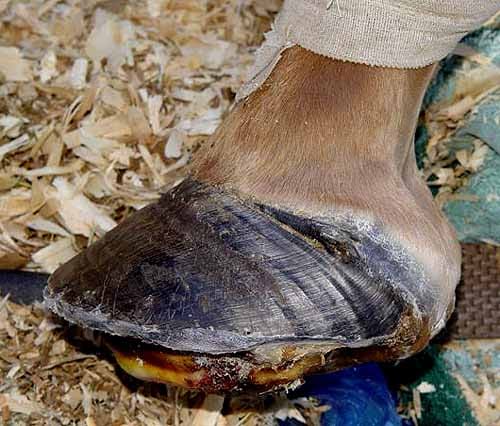
A real-life example of most of the laminar connection detached. This hoof is severely foundered.

This hoof also had sole penetration where the sole wore away in the toe area, exposing the coffin bone.
I have gotten better results on my foundered horse using a FREQUENT barefoot trim than with using horseshoes. This trimming style is based on the shape of wild horse feet, as described in Jaime Jackson's research on wild horses, and Dr. Hiltrud Strasser's books, "A Lifetime of Soundness" and "Shoeing: A Necessary Evil?" Dr. Strasser's book has been a tremendous help in understanding the physiology of the hoof and how different trimming and shoeing styles effect it.
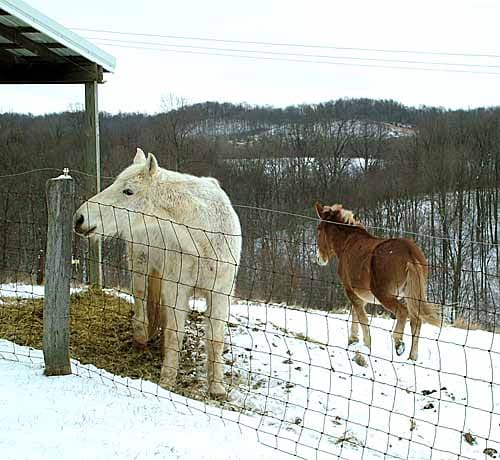

My last photos of Max...early 2004
Sadly, I have to report that my old foundered horse, Max, died March 23, 2004. It was sudden, and while I was away. He was 30 years old, born June 10, 1973. Even a couple of days before, he seemed fine. He was still feisty enough to push my draft mule around. At the time of his death, he was bleeding heavily out of his nose and mouth, and collapsed. The neighbors buried him with their backhoe before I got home, so I never did have a chance to have a necropsy done to know for sure the cause of his death...or to even say goodbye. His teeth were not good, and he was starting to have trouble keeping weight on. But he survived more than 10 years after having sole penetration...his soles just filled back in and stayed that way. He has been such a good friend for so long, it is almost inconceivable that he is gone. Foundered horses all over the world have benefited from what he inspired me to learn and share with others. But to me, he was more of a dear friend than an honored catalyst for progress. No longer can I bury my face in his mane, which smelled so good, or look into his beautiful eyes. It will never be the same. He is missed so much by so many. My mule is just lost without him.
...Rest well, sweet prince!
The success of this approach to laminitis hinges on trimming the feet OFTEN (every 3-4 weeks an absolute bare minimum), keeping the horse on firm, non-concussive ground during the recovery period when he is barefoot, and using removable boots when working him on hard or rocky ground to prevent stone bruises--until enough sole and hoof wall thickness builds up, and enough stronger new laminae grow down to return the coffin bone to a more normal position.
Actually, trimming every 3-4 weeks is not often enough for optimum results. Dr. Strasser gets her spectacular results trimming 2-3x weekly. This more closely mimics the ideal state, where a horse is exercising enough on varied (partly rocky) terrain that he wears himself down constantly and never needs trimming. When you trim this often, you are not taking much off at a time. They are tiny little tune-ups on the trim.
Although I discuss medications and nutrition to treat laminitis, the heart of what I am advocating involves repairing lamintis by INCREASING CIRCULATION and RESTORING THE BOTTOM OF THE COFFIN BONE TO A GROUND-PARALLEL POSITION by primarily mechanical means....frequent trims, and more movement from constant turnout in the company of other horses.
Restoring the bottom of the coffin bone to a ground-parallel position is one of the single most important aspects of both fixing and preventing rotation in the future.

(Image courtesy of Dr. Hiltrud Strasser)
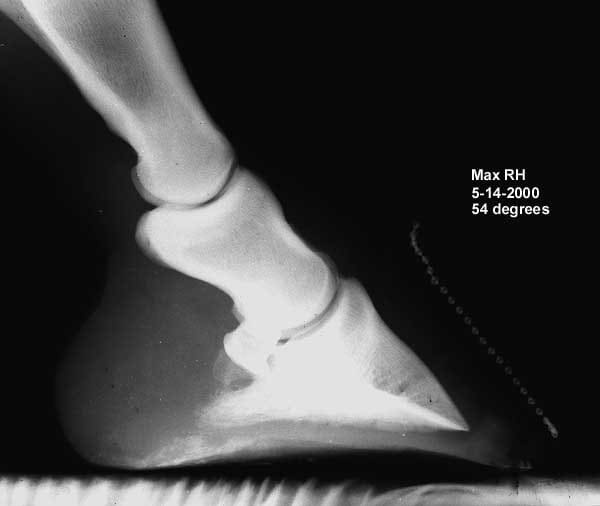
Normal foot (no rotation) trimmed for
a ground-parallel coffin bone--Max, RH
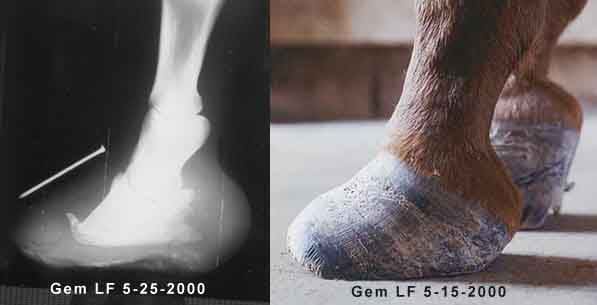
Severely foundered foot
(rotation 30 degrees before toe profile backed up)
trimmed for a ground-parallel coffin bone
Note high heels on right hoof, which was not trimmed yet.
(Also note how tip of coffin bone remodeled due to long-term high heels.)
X-rays are the acid test of whether or not the bottoms of your horse's coffin bones are ground-parallel. There are many problems with x-rays, though. Click here to see some problems x-rays can have
| To quote Dr. Strasser (from Jaime Jackson's newsletter):
The same steep hoof form responsible for navicular is also responsible for deficiency of blood flow and chronic overload of the dorsal part of the laminae, which sets the stage for acute laminitis. [....X-ray] Studies of wild horses show the [bottom of the] coffin bone of a natural foot parallel to the ground and the frog/bulbs actually touching the ground. Domestic horses, however, are largely forced to live with high heels and no frog contact. A change in the distribution of pressure results; the steeper the coffin bone, the more weight moves to the tip of the coffin bone and the more the laminae there are overloaded. Soft ground is less harmful under these conditions than hard ground. The overloading of the laminae can be borne for some time if there is optimal circulation and good horn quality (unshod hoof.) If anything like a metabolic disorder occurs, such as an excess in protein, the overloaded area becomes inflamed. Horses show pain and shift their weight rearward, onto parts of the hoof where the laminae are still intact. With wild horses, acute laminitis heals quickly, since the animal has to migrate with the herd, and circulation resolves the laminitis within a few days. The rearward shift also shortens overlong heels. [.....] The use of wedge pads or bar shoes only increases the problem, doubling pressure put onto the damaged region. Cells in the already damaged area die off, while cells on the edges of the afflicted area remain inflamed, producing wound secretion instead of stabilizing horn. Acute laminitis, therefore, is a long time in the making. The "sudden" appearance of laminitis is brought on either by additional overload or several possible poisonous ingredients; however, these are not the causes for the laminitis, but rather the "straw that broke the camel's back." Pollitt shows dramatically in his video that a steep hoof is insufficiently supplied with blood; this is especially severe when the horse moves little, because it means long persisting vasoconstriction without the short frequent opening by joint motion. So far, 50 horses with acute laminitis were healed exclusively by lowering the palmar processes (bringing the hoof, and as such the coffin bone, back into its original position through trimming), and optimizing blood flow through the foot with movement, not medication or shoeing, etc. Removing the cause (overload of the coffin bone) took 2-8 weeks, depending on the stage of the disease at the beginning. After 3-5 months, as soon as 75% of the coffin bone was tightly connected with the laminae again, the horse was able to move pain-free. |
Further, an X-ray of a wild horse foot, published in Jaime Jackson's newsletter, shows that having the bottom of the coffin bone ground-parallel IS what is natural, not the high-heeled shoeing scenarios currently in vogue:
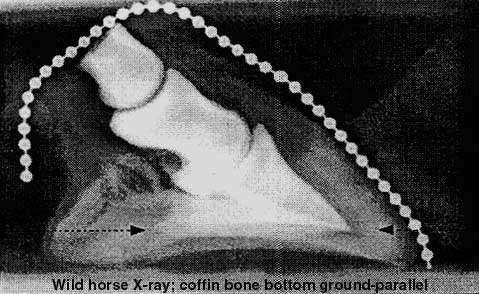
The idea of aiming for a ground-parallel coffin bone is not new, however. In the 1894, David Roberge published "The Foot of the Horse, or Lameness and all Diseases of the Feet Traced to an Unbalanced Foot Bone, Prevented or Cured by Balancing the Foot." While Roberge was still using shoes, he at least was advocating correct hoof balance. Click here to see some of Roberge's drawings
I am very heartened to see that the ground-parallel coffin bone idea is being revived in the farrier community! Check out the articles below on the American Farriers Association web site by Michael Savoldi, resident farrier at California State Polytechnic University at Pomona for 28 years. The dissections illustrating the article are well worth looking at. While he talks about trimming walls even with the live sole plane to get a 'uniform sole thickness,' his last photo in the 2nd article clearly illustrates trimming that results in a ground-parallel coffin bone. I have been in favor of trimming in a way that follows the form of the underlying structure, and am in agreement with what he is showing. His comments about how an unbalanced hoof will result in sole distortion and coffin bone remodeling are well taken, and I have some x-rays illustrating coffin bone destruction in Section 7 of this site.
http://farrierart.com/Uniform%20Sole%20Thickness%20-%20Michael%20Savoldi%203%20pages.pdf
Hairlines--a gauge we can use to estimate how the bottom of the coffin bone is positioned:
For front to back balance, which the above image from Dr. Strasser refers to, this is the slope we are looking for:
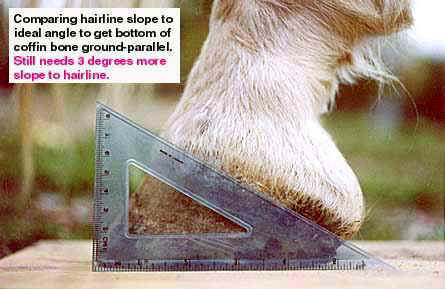
(Max's heels still a bit too high.
We want the hairlines the same slope as the 30 degree triangle.)
You need to view the hoof from ground level.
Getting the correct hairline slope always involves LOW HEELS.
For lateral balance, we also use the hairlines, or alternately, the grain of the hoof wall in the center front. First, you need to determine the center of the toe, and mark it:
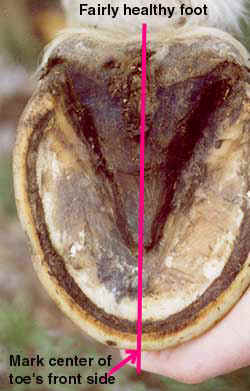
Max, right hind, showing where I mark the center front.
(Hard to tell just looking at it that this foot was once foundered!)
Scroll up a little for x-ray of Max's RH.
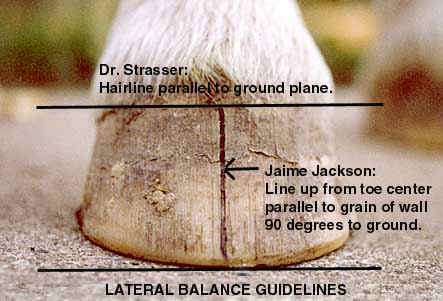
Showing 2 alternative methods of achieving lateral balance.
You need to view the hoof from ground level, directly in center front of the hoof.
By trimming in a way that will get the bottom of the coffin bone ground-parallel, you:
1. Distribute the weight evenly on all the laminae, rather than just over-stress the laminae in the toe area. Lateral balance is important, but the front to back balance is even more crucial with founder.
2. Relieve the pressure point of the tip of the coffin bone on the toe area of the sole. This enables the horse to grow in stronger, harder sole horn in the toe area. Since I put more emphasis on getting Max's hairlines sloped correctly, his soles in the toe area are getting much harder. This is what will enable a horse to go barefoot on gravel eventually.
Books of Interest
To order Jaime Jackson's Books:
(In association with Amazon.com. Online ordering; credit card orders accepted.)
The Natural Horse--Foundations for Natural Horsemanship--Click here
Studies of wild horses and herd life; lessons from the wild applied to trimming, housing, riding, horse handling and hoof care. In this earlier book, he was still afraid to come out and endorse riding without shoes because his other findings might not be "heard" by the farrier community. Wild hoof studies presented are very interesting.
Founder: Prevention and Cure The Natural Way--Click here
Jackson advocates keeping a horse in the environment and on the diet of the wild horses he studied--desert-like conditions, varied but sparse vegetation, rough terrain, etc. For those of us in soft terrain with lush grass, he recommends dry-lotting, which I disagree on; I believe it still can be made to work. Some discussion of trimming, and he warns you about some high-tech shoeing options he does not believe in that are in common use.
Horse Owner's Guide to Natural Hoof Care--Click here
An overview of how Jackson trims.
Paddock Paradise--Click here
Jackson's ideas on how to encourage natural wear and more movement in your pasture.
To order Dr. Strasser's Books:
A Lifetime of Soundness, by Dr. Hiltrud Strasser and Sabine Kells. An overall introduction to the Strasser method of rehabilitation, why keeping the horse as naturally as possible is better than stabling, stall confinement, shoeing, etc. Click here
Shoeing: A Necessary Evil?, by Dr. Hiltrud Strasser and Sabine Kells. Click here Focusing more on what is detrimental about shoeing.
Who's Afraid of Founder? Laminitis Demystified: Causes, Prevention and Holistic Rehabilitation Click here
Navicular No More, Click here Far from being a hopeless condition, often "navicular" can be healed with correct hoof form.
Metal in the Mouth, Click here The adverse effects of using bits are more far-reaching than we might realize.
Barefoot Stories, edited by Yvonne Welz, featuring cases using the Strasser method to rehabilitate horses. Click here
Also Available--
"The Hoofcare Specialist's Handbook: Hoof Orthopedics and Holistic Lameness Rehabilitation," by Hiltrud Strasser, DVM, and Sabine Kells. Over 800 pages. The textbook for the Strasser hoofcare specialist course. Admittedly very expensive. For ordering info, Click HERE.
To order additional recommended books on lameness:
The Lame Horse, by James Rooney, DVM--a classic reference. All types of lameness covered. Cross-sections, diagrams, x-rays, diagnosis, treatment options. Dr. Rooney is pro-barefoot. Click here to order Click here to Preview
Color Atlas of the Horse's Foot, by Christopher C. Pollitt, PhD., MRCVS--remarkable book, numerous dissections, cross-sections, all sorts of lameness and abnormalities shown. Expensive, but worth it! Click here
Vintage farrier books on balancing feet:
High heels were not always the fad they are now!
The Foot of the Horse, by David Roberge, reprinted in paperback, which advocated a ground-parallel coffin bone over 100 years ago, even though it also emphasized shoeing. Click here
The Art of Shoeing and Balancing the Trotter, by Charles Arthur McLellan--another vintage book on balancing feet. Click here
The Cavalry Horseshoer's Technical Manual, by US War Dept. (Another vintage farrier manual that did not advocate high heels, or steep toe angles in the fores--Click here
(In association with Amazon.com. Online ordering; credit card orders accepted.)
Back to home page--Table of Contents
Article in sections with "thumbnail" photos for fastest downloads:
1 9 17
2 10 18
3 11 19
4 12 20
5 13 21
6 14 22
7 15 23
8 16 24
NAVICULAR
Article in sections with full-sized photos for print-outs:
1 9 17
2 10 18
3 11 19
4 12 20
5 13 21
6 14 22
7 15 23
8 16 24
NAVICULAR
To Strasser case studies--thumbnail photos for faster downloads
To Strasser case studies--large photos
Please sign my guest book! Photos of my pets My farm
Share Barefoot success stories on this page
Buy or sell used HORSE BOOTS Natural board Barn Listings
Click here to subscribe to naturalhorsetrim
(I moderate this listserv to weed out "fluff.")
Send Email to Gretchen Fathauer, or call (740) 674-4492
Copyright by Gretchen Fathauer, 2015. All rights reserved.